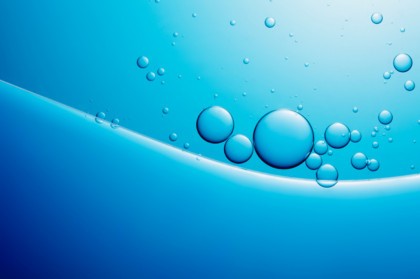
Bubbles, as we all know, work a treat in champagne, baths and chewing gum, and now they’re being used to potentially save lives worldwide via fascinating and revolutionary medical research.
Minute bubbles – smaller in width than a human hair – are being tested in laboratories across the globe to clear blood clots, improve the outcome of chemotherapy and reduce the long-term damage after a person suffers a heart attack.
These “micro bubbles” have a fatty protective outer layer and contain powerful drugs in their centre. After being injected into a person’s bloodstream, they are carried to the part of the body that requires medical treatment. The bubbles are then targeted by ultrasound waves that burst them, directly releasing the drugs to where they’re needed most.
“They are very versatile, there seem to be no real side effects and they can be used for diagnostic purposes or as a vehicle to transport different drugs,” Professor Karlheinz Peter, head of atherothrombosis and vascular biology at the Baker IDI Heart and Diabetes Institute in Melbourne, says.
“I think micro bubbles will be used a lot more in the not too distant future.”
Finding & fixing blood clots
In North America, patient trials are using bubbles to break up blood clots in vessels which lead to the brain. Bubbles are injected into the bloodstream and they float to the site of the clot, where they are targeted by ultrasound waves.
This forces the microbubbles to expand and contract against the clot until it breaks.
This bubble procedure is currently under investigation at the Baker Institute in an attempt to help identify clots that cause heart attacks.
“When a patient arrives at an emergency department with a heart attack, in about two-thirds of cases we don’t have a clear-cut electrocardiogram sign,” Peter explains. (An electrocardiogram, or ECG, tests for abnormalities in the heart.)
“We then have to do blood tests and wait for results, and you need to have had symptoms of heart attack for three or four hours for positive blood test results,” he says. “So blood tests don’t help much in diagnosing heart attack.
“Our idea is to use these microbubbles with antibodies on the surface that quickly recognise clots. Combine this with an ultrasound and you have a way to diagnose a heart attack within two or three minutes.”
Reducing the damage in the aftermath of heart attack
After a heart attack, some heart tissue is damaged and left scarred, reducing the amount of healthy, functioning heart muscle. The vibrating microbubble procedure may one day be able to reduce the amount of scarring that occurs.
Cardiologists at Bonn University Hospital, in Germany, found that releasing tiny gas bubbles into the heart of mice after a heart attack and making those bubbles bounce around decreased scar tissue.
“The pumping function was significantly better in the treated animals as compared to the control group; there was also a significantly smaller amount of decayed heart muscle tissue,” Dr Jonas Dörner, one of the German researchers, says.
It seems the microbubbles increase growth hormones in the heart, which reduces scarring.

Improving radiography results
As tumours grow bigger, some tumour cells end up with poor oxygen supply, making them more resistant to radiotherapy – enter the bubbles. At the University of Colorado, oxygen microbubbles have been injected into tumour tissue. Ultrasound is then used to burst the bubbles so they release their oxygen into oxygen-starved tumour cells. The treatment has so far been tested on animals but could soon begin human trials. “If a tumour outgrows its blood supply, you get tumour cells that aren’t well oxygenated,” Professor Ian Olver, CEO of the Cancer Council Australia, says.
“If you can release these bubbles with their oxygen in the middle of a tumour it may well re-oxygenate those cells and make them more sensitive to radiotherapy,” he says.

Improving the results of chemotherapy
Bubbles may increase the power of chemotherapy and reduce its side effects. Bubbles containing chemotherapy drugs are injected into the bloodstream and once they reach a tumour they melt within about 20 seconds, releasing the drug inside. Scientists at Duke University in the US have tested the procedure on breast cancer survivors who have a recurrence of cancer in their chest wall.
They say bubble therapy delivers 30 times more chemotherapy to a tumour than standard treatment, and with fewer side effects. “The liposomes [bubbles] melt only within the tumour, and the rest of the body receives relatively less of the toxic drug,” senior investigator Dr Mark Dewhirst, Professor of Radiation Oncology, says.
Olver believes the treatment will offer benefits for patients. “Once you put chemotherapy into blood, every cell along the way can take it up – bone marrow, hair follicles and the lining of your mouth,” he says.
“Targeting cancer with microbubbles means the drug isn’t released in the rest of the body to create side effects. This new research certainly has potential.”
Emergency oxygen
Bubbles containing oxygen could soon be saving lives in emergency departments. The fast-acting bubbles contained in an injectable foam have been developed at Boston Children’s Hospital in the US and deliver vital oxygen to patients at risk of dying or those suffering organ failure due to lack of oxygen.
In tests, the bubbles boosted dangerously low oxygen levels within seconds. If the therapy continues to prove effective in animal trials it could become part of CPR, as well as a treatment for lung infections or asthma attacks.
“This is a short-term oxygen substitute – a way to safely inject oxygen gas to support patients during a critical few minutes,” says Dr John Kheir of the Department of Cardiology at Boston Children’s Hospital.
“Eventually, this could be stored in syringes on every code cart [a cart carrying emergency equipment and supplies] in a hospital, ambulance or transport helicopter to help stabilise patients who are having difficulty breathing.”
Source: bodyandSoul
 We are sharing information for knowledge. Presented by. SocialDiary.Net
We are sharing information for knowledge. Presented by. SocialDiary.Net



